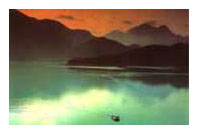Search
Related Articles
Sponsor Ad
Chinese Culture >> Taiwan Culture >> Sun Moon Lake, Taiwan
Taiwan For Lovers: Visiting the Sun Moon Lake
Lugang (Taiwan), Nov 28 (DPA) Love has found
a home at Taiwan's Sun Moon Lake. Walking along the waterfront, it's not
uncommon to see couples strolling hand in hand or kneeling men making marriage
proposals.
 One-in-10 Taiwanese newlywed couples heads here for the honeymoon. The lake got
its name from its shape, which resembles the northern Chinese symbol for 'sun'
and the southern Chinese symbol for 'moon.'
One-in-10 Taiwanese newlywed couples heads here for the honeymoon. The lake got
its name from its shape, which resembles the northern Chinese symbol for 'sun'
and the southern Chinese symbol for 'moon.'
For all the lake's charms, getting there remains half the fun. Taiwan is not
particularly large. Despite its population of 23 million, it could easily fit
into the space of Switzerland. It's only a few hours drive from the hectic
capital city of Taipei to the sparsely inhabited mountains around the lake.
On the way, visitors drive past rice fields and banana plantations. There's no
reason to rush, meaning plenty of time for stops at places like the Wu Wei
Culture Tea House in Taichung.
Built in the traditional style and situated next to a small lake, the teahouse
boasts a covered terrace stretching over the water, filled with splashing red
and yellow koi.
'We think that a comfortable atmosphere is important for truly enjoying tea,'
says Lin Chun-chun, as she serves the hot beverage. She enters the room with a
wooden tray; decked out with a teapot, tall, narrow glasses and small bowls.
First Lin heats several large teapots. Next, she pours hot water into a smaller
teapot before pouring the water into the larger pot, which has been filled with
green tea. After letting it steep for a short while, Lin pours it into the tall
glasses. But the tea in these glasses is only for sniffing.
Then it's poured into the flat saucers, from which it is slowly drunk while the
next serving steeps. The procedure can be repeated up to seven times.
Lugang is also worth a side trip. The city is known for its craftsmen, working
in small courtyards as they carve furniture or statues of Buddha. Wu Duen-how, a
renowned master of making traditional lanterns, is the most famous.
Wu is more than 80 years old and has been making and painting the lanterns for
60 years. He has no plans to stop because he already has so many images of new
lanterns in his head, he says.
The landscape starts getting more hilly between Lugang and the lake.
Forests with metre-high bamboo stalks line the road. The lake is at an elevation
of 748 metres. The early morning hours are best, with the mountains coming into
view as just a few boats glide along the water. During the day, boats head en
masse to Lalu Island in the middle of the water.
Before roads were built around Sun Moon Lake, ships berthed at the foot of the
Wenwu Temple, on the northern bank. Visitors have to climb 360 steps,
symbolizing a year of hard work. Even today, each step represents a certain day.
Many are engraved to highlight the birthday of a prominent person. The temple
itself is a symbol of religious tolerance. Next to shamanistic war gods,
visitors can also find an image of Confucius.
Visitors can also take their entreaties to the Tsen Pagoda on Shapalan Mountain.
The view over the sea is breathtaking, especially in the evening as the sun
sinks behind the mountains. And, as some visitors start the walk back home, a
few couples stay behind, close together and lost in one another.
About the Author:
Nerve.in
